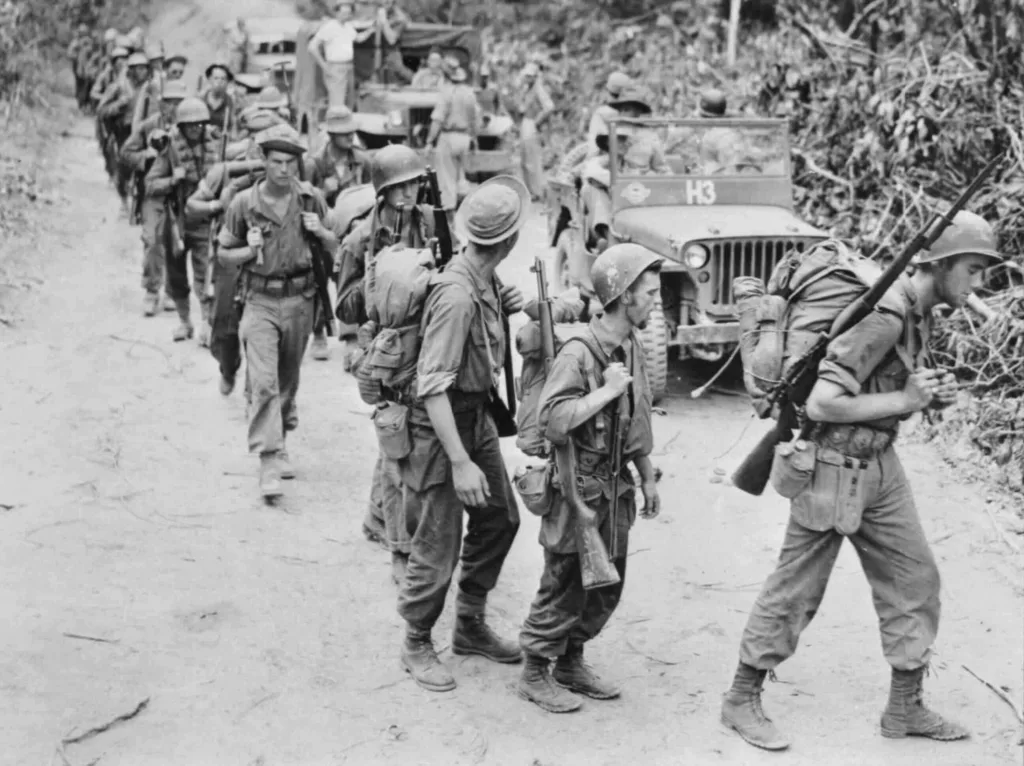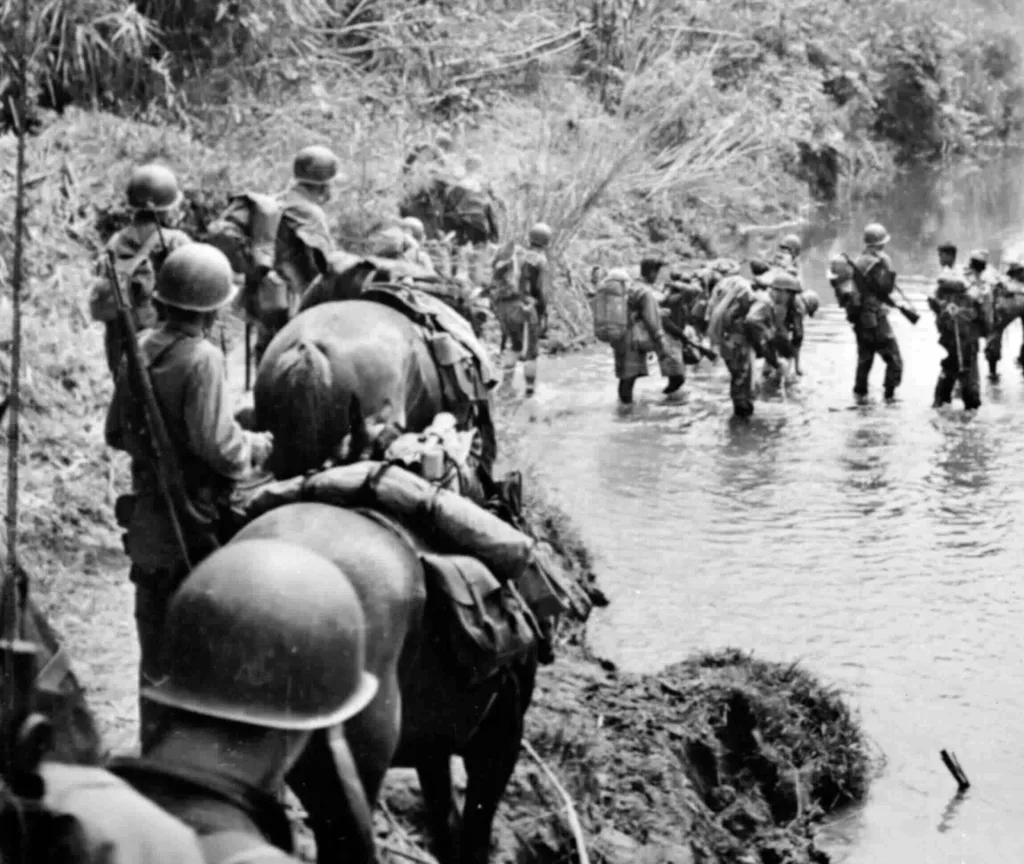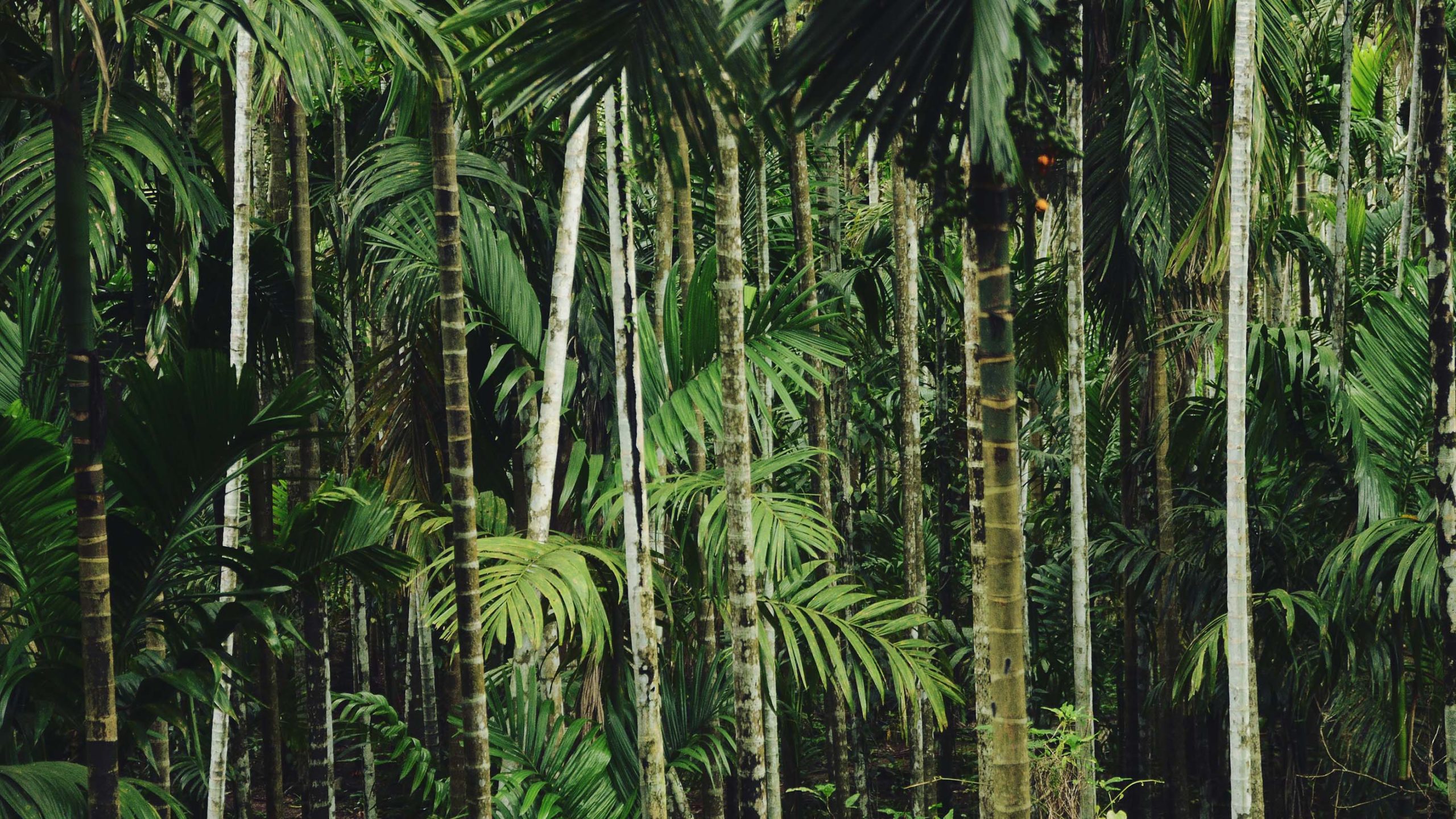At some point in 1977 the Daytona Beach News-Journal published an article about my grandfather and his service in World War II. I have a faded black and white photocopy of the story and have transcribed it here. There was a great photo of Papa and the other veteran featured in the article, but unfortunately the image looks terrible when scanned.
By MARY McLACHLIN
News-Journal Staff WriterThey meet again after 32 years — the burly ex-middleweight from Arkansas and the tough, smooth Italian who liked being called Sgt. Wop.
Cpl. Thomas K. Armstrong and Sgt. Vincent Albanese are survivors of Merrill’s Marauders, the near suicide mission that kept the Japanese from overrunning Burma and joining forces with the Germans in Africa.
The column is winding down Ledo Road,
A blend of mules and men.
The regiment has orders to cross Burma’s borders,
Deep into the enemies’ den.Tom, 60, and Vinnie, 59, sit in the Armstrong living room at 455 State Ave., Holly Hill, looking at old photographs, comparing jungle rot and saying countless “remembers.” They hadn’t known until now that they lived only two blocks from each other. Armstrong happened to see the Albanese address, 122 Azalea Drive, Daytona Beach, on a Merrill’s Marauders Association list and telephoned for a reunion.
The 3,000 men who volunteered in 1943 for a “hazardous mission” in the China-Burma-India war theater weren’t really expected to come back. They were code named Galahad and considered an expendable force, a sacrifice to harass and possibly hold the Japanese until the war in Europe was cooled down and the Allies could turn their attentions to the jungles. Ostensibly, their mission was to cut the enemy supply line at Walawbum, an operation estimated to take a year.
What the War Dept. hadn’t counted on was the toughness of the Galahads, and Brig. Gen. Frank Merrill‘s knowledge of the Japanese.
Japanese roads are promptly cut
Near a village called Walawbum.
To hold in place, men quickly brace
For the attack that soon must come.Armstrong has been to one of the annual Marauder reunions, last September in Philadelphia. He plans to be at the one in St. Louis this year. Albanese hasn’t been to one yet. The two have trouble placing each other in their jungle memories at first.
“Do you remember the guy with the machinegun on the riverbank? That was me.”
“Yeah. I remember, because I was the guy with the carbine right below you.”
“That was you? But you were small!”
“That’s right. Just a skinny little thing.”
There were no fat ones. Lack of food and too much disease took care of that. They had malaria, dysentery, jungle rot, and a terrible strain of typhus that pushed fevers to 110 degrees. More died of disease than of battle. Of the 3,000 who went in, only 1,000 came out.
Marauder guns chant macabre dirge,
As soldiers ply their trade.
The choruses swell like sounds from hell,
And scores of new widows are made.“There wasn’t a man in the outfit who hadn’t been wounded at least three times,” says Armstrong. Medical help was where you found it. With a mortar fragment hole in his stomach, Armstrong dumped some sulfate powder into the opening, tied rags around his middle to stop the bleeding and waited. The next day a medic caught up with them and stitched the wound.
Albanese has four bullet and shell holes in him, but he recalls other soldiers’ injuries too. The night he pulled several wounded out of shelled bunkers, he remembers one man whose middle was slashed open. Grasping his own stomach in both hands, he says, “I held his belly together, like this, until a surgeon came by and sewed him up.”
The bloody baptism is over,
Eight hundred of the enemy lie dead,
While down through the ranks, the men give thanks
That hardly a Marauder had bled.One Galahad was dead and six were wounded. They had killed 2,000 Japanese soldiers and taken Walawbum in one week, instead of the year estimated by Washington. Gen. “Vinegar Joe” Stilwell decided to send them deep into the jungle toward the airstrip at Myitkyina (Mish-I-nah).
“We split into combat teams instead of staying in regular units,” explains Armstrong. “We moved all over the place. The Japs couldn’t tell how many of us there were. They thought there were 15,000 of us. We were the first real Rangers the army had, only we weren’t called that.”
A soft command. Men get to their feet.
Silently the column moved out.
Less fear of a trap by the cruel, cunning Jap,
With a native Kachin for a scout.“Remember ‘Pistol Pete’? I’m the one who took the picture that proved it was only one gun.” Armstrong shows two photos, one of a group of Japanese soldiers sitting on the ground, then one of them hauling a huge gun across an opening. The 155mm field piece had confounded the Americans; they thought it must be several guns because it was being moved around to so many positions.
Albanese also shows a photo, of himself and seven or eight other grimy, bare chested soldiers, all lean and tough looking. A small Burmese boy, squatting in front, also grins at the camera.
“This guy here,” he points,” he and I are the only ones alive. We had to kill the kid. Caught him sneaking out at night to the Jap lines to report our positions. That’s why all these other guys are dead.”
Machine guns snarl in the jungle ahead.
A wounded man stumbles and trips.
A groan of pain as he rises again,
To fall with a curse on his lips.War brutalizes those who fight it and those who suffer it. “We were ordered to kill everything that moved, and that’s what we did. Women, children, everything. The more we killed, the more I wanted to kill. That’s just how it felt.” The quiet voice of Albanese, a middleaged grandfather and solid citizen, seems detached from the words as he remembers.
Vultures are cheated; men bury their dead.
No time for mourning now.
The troops and guns of the Rising Sun
Hold distant Myitkyina.“We didn’t wear any insignia, not even the officers,” Armstrong says. Albanese recalls an officer dressing him down: “You call me ‘Sir’ one more time, and if a Jap doesn’t shoot me first, I’m gonna shoot you!”
Food consisted of K rations — when the C47s made the supply drops — and what could be scrounged. Some men carried opium, a useful bartering tool.
“We’d trade for a chicken, see? We weren’t allowed to build fires, so we’d get out in the jungle and start firing our water cooled machine guns until the water got boiling hot, then use it to pluck the chicken and cook it as best we could. Otherwise we ate it raw,” Albanese remembers.
The horsemen of the Apocalypse
Repeatedly slash at their flanks.
Until at length they have drained the strength
From steadily dwindling ranks.“But wasn’t that great fishing in the Irrawaddy?” Armstrong asks, prompting a laugh from both men. “Sure was. Just throw in a grenade, and you had all the fish you wanted.”
Other pleasant memories come back, things that relieved the horror they came to accept as daily life.
“You know the most beautiful thing I ever saw? When we pulled into port in South Africa, there was a carrier, and on the deck was Kate Smith singing God Bless America just as we went by. That was the most beautiful sight of my whole life.”
The one time some of the men got to a rest camp, named Camp Landis after Movie Star Carol Landis, entertainers were putting on a show for them — the only one they would get to see — when they had to go into blackout because the “Washing Machine” had arrived. That’s what they called the Japanese bomber which patrolled the area regularly. Often they sent a detail out to place lighted flashlights in the jungle a couple of miles from camp, to give the Washing Machine something to aim for.
At Myitkyina British and Chinese are joined
To reverse the tide of war.
And a haggard band of a hundred stand,
Where a regiment once stood before.The entire Galahad operation was plagued with command failure from beginning to end. Frank Merrill had two heart attacks, and dissension was constant among the other ranking officers. The result was that the men suffered, and some died — needlessly — for lack of intelligent leadership.
They were pulled out of hospital units and sent back to front line duty because or order mixups. Despite their unquestioned battle accomplishments, most survivors never got their earned medals and citations, and often were treated as outcasts by other units. A subsequent book by Col. Charles Newton Hunter, responsible for much of the Galahad command, detailed the bitterness that developed.
Armstrong was assigned to flight duty, becoming a “kicker” on the C47 supply drops for men in the Central Burma campaign jungles, after the fall of Myitkyina. His plane crashed in a rice paddy, resulting in a severe head injury which kept him unconscious for the next two months. It probably was a blessing, he concedes, because his whole crew was captured, and he woke up in a prison camp somewhere in Thailand. When they escaped, it took them nearly six weeks to get back to their lines.
Like sun on the Irrawaddy
Dissolves the morning mist,
The campaign won, their task is done,
As Marauders they cease to exist.Armstrong says he doesn’t care about the medals he never received, but he was angered by the treatment he got from Army brass because of his wounds and shell shock. He’s retired now, and receives medical disability benefits. Albanese says he’s “never gotten a penny” in benefits, despite his four wounds. He’s semiretired from the construction business.
The Marauders are still a proud bunch, as the stanzas of their ballad, written by John E. Devine, will show. The disease, death, brutality, and even ill treatment at the hands of their own service fade when they sing the last verse of their song:
A blade was forged
From the crucible of fate,
And wielded with honor in war.
Now battered and bent
The blade is well spent.
Eternal, the honor it bore.
The following is copied from the March 17th, 1944 page on the World War II Today website.
Burma – Battles behind the Lines
17th March 1944: In mid March both the American ‘Merrill’s Marauders’ and the British ‘Chindits’ engage the Japanese deep in the jungle

A U.S. image of ‘Operations in North Burma 1944’ probably the Marauders departing on their long trek into Burma.

Both the British and the Americans launched what would now be described as ‘Special Forces’ operations deep into Burma in the first months of 1944. The Chindits had pioneered a deep penetration operation in 1943 – disrupting the Japanese lines of communication way behind the acknowledged ‘frontline’.
Their commander, Orde Wingate, got support for a further operation when he attended the Quebec Conference of Allied leaders in August 1943. Partly as a consequence, the US Army decided they would also form a special unit to conduct a parallel operation in Burma in 1944.
The 5307th Composite Unit (Provisional) was the consequence. They were soon better known as ‘Merrill’s Marauders’, after their commander. In early February 2,750 men began a 1,000 mile march across the Patkai mountains of northern Burma. It was an arduous trek and the nutritional value of the rations they carried was not equal to what was expected of them.
Nevertheless the Marauders succeeded in penetrating deep behind Japanese line and then engaging them in a series of violent clashes.
Captain Fred O. Lyons1 left this account of one of their first engagements with Japanese:
Battalion headquarters was issuing orders to spread out in formation, and the column was splitting up ahead to move off the trail. Finally I learned what had happened. The pointmen – lead scouts – had run into four Japs riding an elephant. They had killed three, but one had escaped. We knew then the Japs would have us spotted. We circled into our wagon wheel and dug the holes for the coming scrap.
